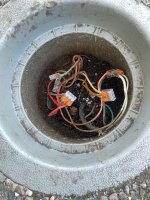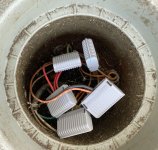Water in below-deck junction box [Was: A new mystery leak]
- Thread starter Rocket J Squirrel
- Start date
You are using an out of date browser. It may not display this or other websites correctly.
You should upgrade or use an alternative browser.
You should upgrade or use an alternative browser.
But seriously, is it possible that code hadn’t been written in 1988 when the pool was built? It seems so strange to put a junction underground. Somebody did that on purpose all those years ago.
This was not disclosed to us when we bought the house in 2012. Now we will have to disclose it if we ever sell the place. The only real fix would involve demolition and excavation of the deck and yard because the wires aren’t long enough to erect a box at the proper level.
This was not disclosed to us when we bought the house in 2012. Now we will have to disclose it if we ever sell the place. The only real fix would involve demolition and excavation of the deck and yard because the wires aren’t long enough to erect a box at the proper level.
I've never seen that type of silliness used on a pool and I've been involved with many that are well older than I am.But seriously, is it possible that code hadn’t been written in 1988 when the pool was built? It seems so strange to put a junction underground. Somebody did that on purpose all those years ago.
This was not disclosed to us when we bought the house in 2012. Now we will have to disclose it if we ever sell the place. The only real fix would involve demolition and excavation of the deck and yard because the wires aren’t long enough to erect a box at the proper level.
My guess is that was someone's attempt at cosmetics over safety and they had no idea what they were doing.
"I keep tripping over this dumb electrical thingy... I'll just make it flush with the ground!"
I know you're joking but the things are never serious until they become serious. I know two of the responders to this incident, one of which was off work for several months following the event due to the psychological trauma...It’s OK. I’ve had a good long life.
Yes, but... in my house files I have the original pool permit on paper. This was permitted!My guess is that was someone's attempt at cosmetics over safety and they had no idea what they were doing.
This was permitted!
See that red word? So what if is WAS permitted back then? You are being told it is NOT safe and would NOT pass now AND your breaker it telling you it is not safe now. This is nothing to laugh about. It needs to be fixed and fixed properly. It might costs your a few bills but in the end it will be worth it to ensure your family and friends are safe in the pool.
You NEED to call in a couple of electric people and ask them what they can do to make it safe and out of sight.
Kim TFP MOD
Can you clean that box completely and snap a pic? It looks like there are several conduits running into it, and I’m wondering if those conduits can be extended above ground, and new wire pulled through.
I get it. I understand that water & electricity don't mix. I will get this resolved. For now, I'm going to plug the conduit to exclude the water and waterproof the wire splices. I want to be able to refill the spa and circulate the water until I can get a pro to look at it.
Installing a raised box may be possible without demolition. There's extra cable in the light niche, so I can pull some of that out. And maybe the other cables can be pulled as well.
In the meantime, there's a really simple way to eliminate the risk: leave the breaker open and don't use the pool lights. We virtually never use them anyway because we only swim in the daytime. The other wires in that junction don't go to water; they power the auto-cover and some outdoor lights and are on a separate breaker.
I appreciate the advice and concern. Thanks for sticking with me through this unfortunate saga.
Installing a raised box may be possible without demolition. There's extra cable in the light niche, so I can pull some of that out. And maybe the other cables can be pulled as well.
In the meantime, there's a really simple way to eliminate the risk: leave the breaker open and don't use the pool lights. We virtually never use them anyway because we only swim in the daytime. The other wires in that junction don't go to water; they power the auto-cover and some outdoor lights and are on a separate breaker.
I appreciate the advice and concern. Thanks for sticking with me through this unfortunate saga.
- Jul 21, 2013
- 52,233
- Pool Size
- 35000
- Surface
- Plaster
- Chlorine
- Salt Water Generator
- SWG Type
- Pentair Intellichlor IC-60
In the meantime, there's a really simple way to eliminate the risk: leave the breaker open and don't use the pool lights. We virtually never use them anyway because we only swim in the daytime.
I was about to suggest that.
The other wires in that junction don't go to water; they power the auto-cover and some outdoor lights and are on a separate breaker.
I appreciate the advice and concern. Thanks for sticking with me through this unfortunate saga.
Note that should your plug leak pool water into the box the other wires will be in contact with the pool water. Is the autocover and outdoor lights on GFCI breakers? Even if they are I would pull the breakers on those circuits also.
In case anyone is still following along... the silicone successfully sealed the conduit and water is no longer entering the junction. I was able to refill and circulate the spa so it's not sitting there stagnant, and I can close the auto-cover with water in the spa to support it. So I've bought some time to figure out a more permanent solution to water vs. electricity. 
This turned into a much longer saga than anticipated.
My next attempt to remedy the "electrocution waiting to happen" (see post 11) was to enclose waterproof wire nuts (they aren't) inside a waterproof junction box (it isn't). I completely filled the j box with silicone goo, leaving no possible point of entry for water. A permanent, waterproof fix! Until it wasn't.
This setup worked fine for 2 years. Then we had an unbelievable series of massive storms this past winter. Poof went the GFCI. Some tiny amount of water had sneaked past the silicone goo. I had to tear out all the silicone, discard the j box, and start over.
I found the WAGO connectors. These appear to be more secure than wire nuts; they actually clamp down on the wires such that the wires can't pull loose accidentally. The smallest ones were just the right size for my wires. But still not waterproof.
Then I found the WAGO Gelboxes. These are specifically made to waterproof the WAGO connectors and are rated at IPX8. Yeah! Ship me half a dozen! But these are not yet available in the USA. WAGO phone rep said "in the fall" and to call back in October or November. Fortunately, the gelboxes are available in England, so I had them imported. Shipping cost more than the devices themselves.
So I think I've finally solved the problem of water in my in-ground junction. Time will tell, of course, but at least I now have connections purpose-made to exclude water. First photo shows the wires with just the connectors; second photo shows the connectors encapsulated in the gelboxes. Wish me luck.


My next attempt to remedy the "electrocution waiting to happen" (see post 11) was to enclose waterproof wire nuts (they aren't) inside a waterproof junction box (it isn't). I completely filled the j box with silicone goo, leaving no possible point of entry for water. A permanent, waterproof fix! Until it wasn't.
This setup worked fine for 2 years. Then we had an unbelievable series of massive storms this past winter. Poof went the GFCI. Some tiny amount of water had sneaked past the silicone goo. I had to tear out all the silicone, discard the j box, and start over.
I found the WAGO connectors. These appear to be more secure than wire nuts; they actually clamp down on the wires such that the wires can't pull loose accidentally. The smallest ones were just the right size for my wires. But still not waterproof.
Then I found the WAGO Gelboxes. These are specifically made to waterproof the WAGO connectors and are rated at IPX8. Yeah! Ship me half a dozen! But these are not yet available in the USA. WAGO phone rep said "in the fall" and to call back in October or November. Fortunately, the gelboxes are available in England, so I had them imported. Shipping cost more than the devices themselves.
So I think I've finally solved the problem of water in my in-ground junction. Time will tell, of course, but at least I now have connections purpose-made to exclude water. First photo shows the wires with just the connectors; second photo shows the connectors encapsulated in the gelboxes. Wish me luck.


Thread Status
Hello , This thread has been inactive for over 60 days. New postings here are unlikely to be seen or responded to by other members. For better visibility, consider Starting A New Thread.

